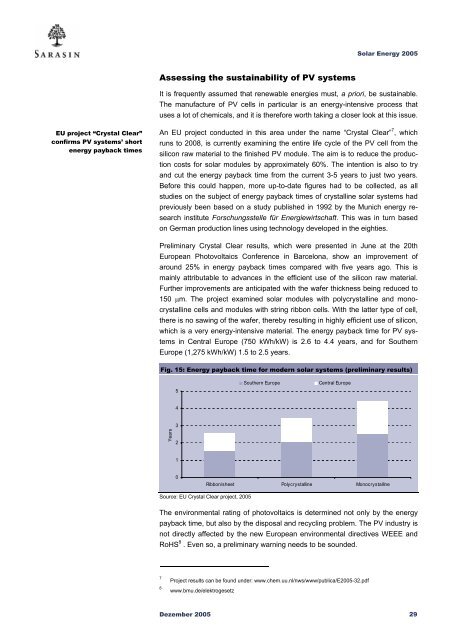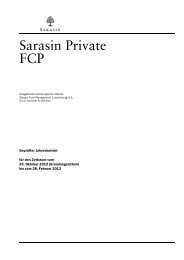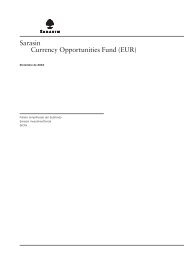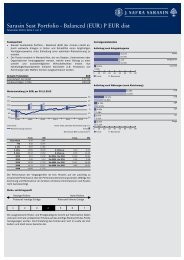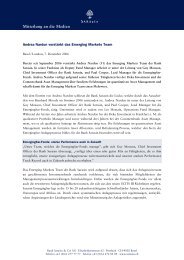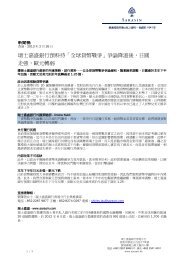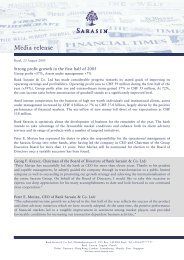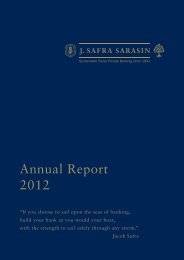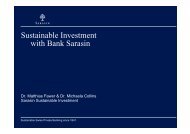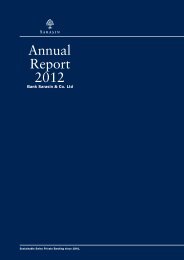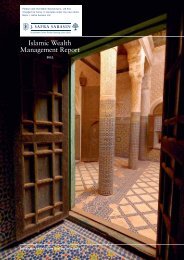Sustainability Report - Bank Sarasin-Alpen
Sustainability Report - Bank Sarasin-Alpen
Sustainability Report - Bank Sarasin-Alpen
You also want an ePaper? Increase the reach of your titles
YUMPU automatically turns print PDFs into web optimized ePapers that Google loves.
Solar Energy 2005<br />
Assessing the sustainability of PV systems<br />
It is frequently assumed that renewable energies must, a priori, be sustainable.<br />
The manufacture of PV cells in particular is an energy-intensive process that<br />
uses a lot of chemicals, and it is therefore worth taking a closer look at this issue.<br />
EU project “Crystal Clear”<br />
confirms PV systems’ short<br />
energy payback times<br />
An EU project conducted in this area under the name “Crystal Clear” 7 , which<br />
runs to 2008, is currently examining the entire life cycle of the PV cell from the<br />
silicon raw material to the finished PV module. The aim is to reduce the production<br />
costs for solar modules by approximately 60%. The intention is also to try<br />
and cut the energy payback time from the current 3-5 years to just two years.<br />
Before this could happen, more up-to-date figures had to be collected, as all<br />
studies on the subject of energy payback times of crystalline solar systems had<br />
previously been based on a study published in 1992 by the Munich energy research<br />
institute Forschungsstelle für Energiewirtschaft. This was in turn based<br />
on German production lines using technology developed in the eighties.<br />
Preliminary Crystal Clear results, which were presented in June at the 20th<br />
European Photovoltaics Conference in Barcelona, show an improvement of<br />
around 25% in energy payback times compared with five years ago. This is<br />
mainly attributable to advances in the efficient use of the silicon raw material.<br />
Further improvements are anticipated with the wafer thickness being reduced to<br />
150 µm. The project examined solar modules with polycrystalline and monocrystalline<br />
cells and modules with string ribbon cells. With the latter type of cell,<br />
there is no sawing of the wafer, thereby resulting in highly efficient use of silicon,<br />
which is a very energy-intensive material. The energy payback time for PV systems<br />
in Central Europe (750 kWh/kW) is 2.6 to 4.4 years, and for Southern<br />
Europe (1,275 kWh/kW) 1.5 to 2.5 years.<br />
Fig. 15: Energy payback time for modern solar systems (preliminary results)<br />
5<br />
Southern Europe<br />
Central Europe<br />
4<br />
3<br />
Years<br />
2<br />
1<br />
0<br />
Ribbon/sheet Polycrystalline Monocrystalline<br />
Source: EU Crystal Clear project, 2005<br />
The environmental rating of photovoltaics is determined not only by the energy<br />
payback time, but also by the disposal and recycling problem. The PV industry is<br />
not directly affected by the new European environmental directives WEEE and<br />
RoHS 8 . Even so, a preliminary warning needs to be sounded.<br />
7<br />
8<br />
Project results can be found under: www.chem.uu.nl/nws/www/publica/E2005-32.pdf<br />
www.bmu.de/elektrogesetz<br />
Dezember 2005 29


